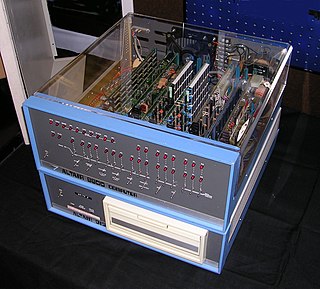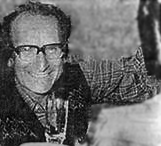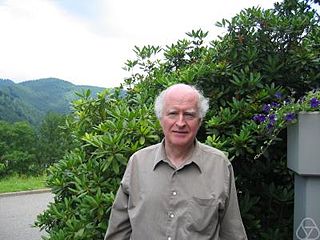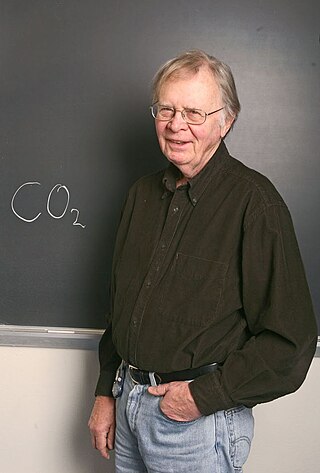Related Research Articles

The Altair 8800 is a microcomputer designed in 1974 by MITS and based on the Intel 8080 CPU. Interest grew quickly after it was featured on the cover of the January 1975 issue of Popular Electronics and was sold by mail order through advertisements there, in Radio-Electronics, and in other hobbyist magazines. According to Harry Garland, the Altair 8800 was the product that catalyzed the microcomputer revolution of the 1970s. It was the first commercially successful personal computer. The computer bus designed for the Altair was to become a de facto standard in the form of the S-100 bus, and the first programming language for the machine was Microsoft's founding product, Altair BASIC.

A monoclonal antibody is an antibody produced from a cell lineage made by cloning a unique white blood cell. All subsequent antibodies derived this way trace back to a unique parent cell.
In immunology, antiserum is a blood serum containing antibodies that is used to spread passive immunity to many diseases via blood donation (plasmapheresis). For example, convalescent serum, passive antibody transfusion from a previous human survivor, used to be the only known effective treatment for ebola infection with a high success rate of 7 out of 8 patients surviving.

Hybridoma technology is a method for producing large numbers of identical antibodies. This process starts by injecting a mouse with an antigen that provokes an immune response. A type of white blood cell, the B cell, produces antibodies that bind to the injected antigen. These antibody producing B-cells are then harvested from the mouse and, in turn, fused with immortal myeloma cancer cells, to produce a hybrid cell line called a hybridoma, which has both the antibody-producing ability of the B-cell and the longevity and reproductivity of the myeloma. The hybridomas can be grown in culture, each culture starting with one viable hybridoma cell, producing cultures each of which consists of genetically identical hybridomas which produce one antibody per culture (monoclonal) rather than mixtures of different antibodies (polyclonal). The myeloma cell line that is used in this process is selected for its ability to grow in tissue culture and for an absence of antibody synthesis. In contrast to polyclonal antibodies, which are mixtures of many different antibody molecules, the monoclonal antibodies produced by each hybridoma line are all chemically identical.

César Milstein, CH, FRS was an Argentine biochemist in the field of antibody research. Milstein shared the Nobel Prize in Physiology or Medicine in 1984 with Niels Kaj Jerne and Georges J. F. Köhler for developing the hybridoma technique for the production of monoclonal antibodies.

John Norman Mather was a mathematician at Princeton University known for his work on singularity theory and Hamiltonian dynamics. He was descended from Atherton Mather (1663–1734), a cousin of Cotton Mather. His early work dealt with the stability of smooth mappings between smooth manifolds of dimensions n and p. He determined the precise dimensions (n,p) for which smooth mappings are stable with respect to smooth equivalence by diffeomorphisms of the source and target.

Wallace "Wally" Smith Broecker was an American geochemist. He was the Newberry Professor in the Department of Earth and Environmental Sciences at Columbia University, a scientist at Columbia's Lamont–Doherty Earth Observatory and a sustainability fellow at Arizona State University. He developed the idea of a global "conveyor belt" linking the circulation of the global ocean and made major contributions to the science of the carbon cycle and the use of chemical tracers and isotope dating in oceanography. Broecker popularized the term "global warming". He received the Crafoord Prize and the Vetlesen Prize.

Georges Jean Franz Köhler was a German biologist.

Ibritumomab tiuxetan, sold under the trade name Zevalin, is a monoclonal antibody radioimmunotherapy treatment for non-Hodgkin's lymphoma. The drug uses the monoclonal mouse IgG1 antibody ibritumomab in conjunction with the chelator tiuxetan, to which a radioactive isotope is added. Tiuxetan is a modified version of DTPA whose carbon backbone contains an isothiocyanatobenzyl and a methyl group.
The nomenclature of monoclonal antibodies is a naming scheme for assigning generic, or nonproprietary, names to monoclonal antibodies. An antibody is a protein that is produced in B cells and used by the immune system of humans and other vertebrate animals to identify a specific foreign object like a bacterium or a virus. Monoclonal antibodies are those that were produced in identical cells, often artificially, and so share the same target object. They have a wide range of applications including medical uses.

Biological therapy, the use of medications called biopharmaceuticals or biologics that are tailored to specifically target an immune or genetic mediator of disease, plays a major role in the treatment of inflammatory bowel disease. Even for diseases of unknown cause, molecules that are involved in the disease process have been identified, and can be targeted for biological therapy. Many of these molecules, which are mainly cytokines, are directly involved in the immune system. Biological therapy has found a niche in the management of cancer, autoimmune diseases, and diseases of unknown cause that result in symptoms due to immune related mechanisms.

Monoclonal antibody therapy is a form of immunotherapy that uses monoclonal antibodies (mAbs) to bind monospecifically to certain cells or proteins. The objective is that this treatment will stimulate the patient's immune system to attack those cells. Alternatively, in radioimmunotherapy a radioactive dose localizes a target cell line, delivering lethal chemical doses. Antibodies are used to bind to molecules involved in T-cell regulation to remove inhibitory pathways that block T-cell responses. This is known as immune checkpoint therapy.
A bispecific monoclonal antibody is an artificial protein that can simultaneously bind to two different types of antigen or two different epitopes on the same antigen. Naturally occurring antibodies typically only target one antigen. BsAbs can be manufactured in several structural formats. BsAbs can be designed to recruit and activate immune cells, to interfere with receptor signaling and inactivate signaling ligands, and to force association of protein complexes. BsAbs have been explored for cancer immunotherapy, drug delivery, and Alzeimer's disease.

Cambridge Antibody Technology was a biotechnology company headquartered in Cambridge, England, United Kingdom. Its core focus was on antibody therapeutics, primarily using Phage Display and Ribosome Display technology.
A rabbit hybridoma is a hybrid cell line formed by the fusion of an antibody producing rabbit B cell with a cancerous B-cell (myeloma).
Jerrold Schwaber was an American biologist and geneticist. In 1973 he described, with Edward Cohen, a method of producing antibodies involving human–mouse hybrid cells, or hybridomas. They fused "mouse myeloma cells secreting immunoglobulin of known specificity and human peripheral blood lymphocytes not secreting detectable immunoglobulin. The hybrid cells continued secretion of mouse immunoglobulin and initiate synthesis and secretion of human immunoglobulin." The antibody producing cells did not survive long and the antigens that the antibodies targeted remained unknown. In 1975, Georges Köhler, César Milstein, and Niels Kaj Jerne, succeeded in making hybridomas that made antibodies to known antigens and that were immortalized. They shared the Nobel Prize in Physiology or Medicine in 1984 for the discovery. His work in laying the foundation for modern monoclonal antibody technology is recognized.

In physics, the Painlevé conjecture is a theorem about singularities among the solutions to the n-body problem: there are noncollision singularities for n ≥ 4.
Richard Paul McGehee is an American mathematician, who works on dynamical systems with special emphasis on celestial mechanics.

Pretargeting (imaging) is a tool for nuclear medicine and radiotherapy. Imaging studies require a high contrast of target to background. This can be provided by using a biomarker which has a high affinity and specificity for its target.
Passive antibody therapy, also called serum therapy, is a subtype of passive immunotherapy that administers antibodies to target and kill pathogens or cancer cells. It is designed to draw support from foreign antibodies that are donated from a person, extracted from animals, or made in the laboratory to elicit an immune response instead of relying on the innate immune system to fight disease. It has a long history from the 18th century for treating infectious diseases and is now a common cancer treatment. The mechanism of actions include: antagonistic and agonistic reaction, complement-dependent cytotoxicity (CDC), and antibody-dependent cellular cytotoxicity (ADCC).
References
- ↑ Kohler, G.; Milstein, C. (1975). "Continuous cultures of fused cells secreting antibody of predefined specificity". Nature . 256 (5517): 495–497. Bibcode:1975Natur.256..495K. doi:10.1038/256495a0. PMID 1172191. S2CID 4161444.
- ↑ Waldman, Thomas A. (2003). "Immunotherapy: past, present and future". Nature Medicine. 9 (3): 269–277. doi: 10.1038/nm0303-269 . PMID 12612576. S2CID 9745527.
- ↑ Naish, Darren (2008-11-24). "New, obscure, and nearly extinct rodents of South America, and... when fossils come alive". Tetrapod Zoology. Archived from the original on 16 December 2008. Retrieved 2008-12-13.
- ↑ Broecker, Wallace S. (1975-08-08). "Climatic Change: Are We on the Brink of a Pronounced Global Warming?". Science . 189 (4201): 460–463. Bibcode:1975Sci...189..460B. doi:10.1126/science.189.4201.460. PMID 17781884. S2CID 16702835.
- ↑ Stefan (2010-07-28). "Happy 35th birthday, global warming!". RealClimate . Retrieved 2012-01-28.
[Broecker's article is] the first of over 10,000 papers for this search term according to the ISI database of journal articles
- ↑ Johnson, Brad (2010-08-03). "Wally's World". Foreign Policy . Retrieved 2012-01-28.
- ↑ Harada, Koichiro (1976). "On the simple group F of order ". Proceedings of the Conference on Finite Groups (Univ. Utah, Park City, Utah, 1975). Boston, MA: Academic Press. pp. 119–276. MR 0401904.
- ↑ Norton, Simon P. (1975). F and other simple groups. University of Cambridge: PhD Thesis.
- ↑ Mather, J. N.; McGehee, R. (1975). Solutions of the collinear four body problem which become unbounded in finite time. Lecture Notes in Physics. Vol. 38. pp. 573–597. doi:10.1007/3-540-07171-7_18. ISBN 978-3-540-07171-6.
- ↑ Saari, Donald G.; Xia, Zhihong (Jeff) (1995). "Off to infinity in finite time" (PDF). Notices of the American Mathematical Society . 42 (5).
- ↑ Chenciner, Alain (2007). "The three body problem". Scholarpedia. 2 (10): 2111. Bibcode:2007SchpJ...2.2111C. doi: 10.4249/scholarpedia.2111 .
- ↑ Selvin, Steve (February 1975). "A problem in probability (letter to the editor)". The American Statistician . 29 (1): 67–71. doi:10.1080/00031305.1975.10479121.
- ↑ Selvin, Steve (August 1975). "On the Monty Hall problem (letter to the editor)". American Statistician. 29 (3): 134.
- ↑ Folstein, Marshal F; Folstein, Susan E; McHugh, Paul R (1975). ""Mini-mental state": A practical method for grading the cognitive state of patients for the clinician". Journal of Psychiatric Research. 12 (3): 189–98. doi:10.1016/0022-3956(75)90026-6. PMID 1202204.
